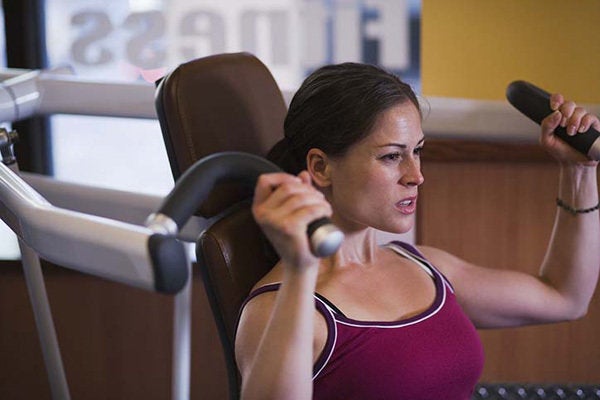
Everyone knows how important it is to get regular exercise, and for many that takes place at their local gyms. But just a friendly reminder for all you gym rats: Health clubs and gyms are known to harbor a host of contagious germs, and people who frequent them are at a greater risk for contracting infections that range from mild (but annoying) to more serious.
In July, the National Athletic Trainers' Association issued a paper stating, "Close quarters combined with general poor hygiene practices make athletes particularly vulnerable to contracting skin diseases." One can easily see how this can be applied to the gym environment as well.
In fact, let's take a look at a typical gym setting. Almost everything is shared, including equipment, exercise mats, lockers and showers. People are wearing exercise apparel, which means more skin is exposed. And for most, a good workout means a good sweat, which equals increased moisture on various surfaces.
So it's not too surprising that a gym, with its public showers, lockers and sweaty clothes, is highly attractive to fungi, bacteria and viruses that thrive in warm, moist places. Direct or indirect contact with moist surfaces that may contain the secretions of others - including sweat and fluids from abrasions or lesions - increases the chances of getting an ugly skin infection.
The Major Germ Culprits
Skin diseases that gym-goers are particularly at risk of catching include:
Fungal infections. These include athlete's foot, ringworm and jock itch, and occur when fungus grows and multiplies on certain areas the body, resulting in a fungal (or tinea) infection.
Athlete's foot is contracted when the feet come in contact with surfaces where the fungus is found, such as sweaty shoes, socks and wet shower floors and pool surfaces. Common symptoms of athlete's foot include cracking, peeling and flaking of the skin, often between the toes; the skin can also become red and itchy. If nails are affected, they can become thick and discolored.
Ringworm gets its name from the characteristic ring-like patches that develop on the infected area of the skin. The patches are itchy, red and raised. Ringworm can appear anywhere on the body. When it affects the groin area, it's commonly called jock itch.
Most minor fungal infections can be treated with over-the-counter products that contain active fungal-fighting ingredients such as miconazole or clotrimazole. Severe or ongoing infections may require a physician's attention.
Staph. Staphylococcus (or "staph") is a group of bacteria capable of causing infection of various body tissues. Staph is normally present in the nose and on the skin of about 30 percent of healthy adults and causes no harm; but, an exposed opening in the skin may allow the bacteria to penetrate the skin's natural barriers and cause a localized infection. Staph is transmitted by direct or indirect contact with someone who has an active staph infection. The affected area becomes red, abscessed and painful, with a boil-like appearance. Treatment usually involves antibiotics. In rare cases, the staph bacteria can enter the bloodstream and spread to other organs, causing more serious complications.
Recently, more attention has been paid to a particular strain of staph called methicillin-resistant staphylococcus aureus, or MRSA. As the name implies, MRSA is resistant to the antibiotic methicillin and other drugs in the same class that are used to treat common staph. This "superbug" was first detected in healthcare and hospital settings, but is now found in the general public. The U.S. Centers for Disease Control and Prevention estimates that about 12 percent of MRSA infections happen outside of a healthcare setting.
Warts. Warts are acquired through direct contact with the human papillomavirus (HPV). Although there are more than 100 types of HPV, the ones that cause warts - particularly warts on the feet, or plantar warts - are often found in damp, warm environments. The virus enters the body through broken skin, and can be transferred from one person to another by touching or sharing personal items such as towels, shaving implements and shoes. Over-the-counter products containing salicylic acid are commonly used to treat warts; freezing is another option.
How to Put Up a Germ-Fighting Front
Of course, the health risks of not exercising far outweigh the risk of potentially contracting germs at the gym. The key is to practice good hygiene. Here are some ways to limit your exposure to infection-causing fungi, bacteria and viruses:
•Keep any cuts or blisters covered with secure bandages. Wearing an article of clothing over an open wound is not enough; sweat easily transmits bacteria or viruses.
•Shower as soon as possible after a workout. The longer you wait around in sweaty clothes after using shared equipment, the higher the chances of getting - and spreading - infection.
•Do not share towels, bar soap, shower slippers, yoga mats or any personal items that come in contact with bare skin.
•Wipe down equipment with antibacterial wipes. At the very least, use a personal towel as a barrier between your skin and any shared equipment.
•Wash your hands before and after working out. Use antibacterial liquid soap or a hand sanitizer with at least 60 percent alcohol content.
•Minimize bare feet's exposure to surfaces, whether wet or dry. Wear slippers or shower shoes to keep feet off communal shower floors, changing rooms and pool decks.
•Wash workout clothes between every gym visit, and wash them as soon as possible after wearing, preferably in hot water.
With a few extra precautions, you can help assure that all you're getting from the gym is a great workout.